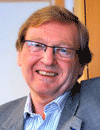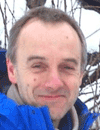Co-Located Conference AgendasAdvances in Biodetection & Biosensors | Advances in Microarray Technology | Lab-on-a-Chip European Congress | Single Cell Analysis Europe | 

Tuesday, 5 March 201308:00 | Registration | |
Next Generation Biosensors and Biodetection Techniques |
| | 09:00 |  | Keynote Presentation Turning Biosensors into Consumer Products
Anthony Turner, Professor, Linkoping University, Sweden
Consumer applications of biosensors for personal health maintenance, food quality and safety, and for environmental monitoring will be reviewed, along with wearable and implantable devices. A new fully-printed biosensing system will be unveiled with the potential to make biosensors as ubiquitous as the RFID tag. |
| 10:00 | Fluorescent Biosensors and Targeted Physiological Indicators for Cell Pathways
Alan Waggoner, Director, Molecular Biosensor and Imaging Center, Carnegie Mellon University, United States of America
We develop fluorescent biosensors toolkits for analysis of pathways of living cells. Focus is on smart biosensors for high throughput methods. Our biosensor platform consists of Fluorescence Activating Proteins (FAPs) that bind fluorogen dyes with large fluorescence increases. Sensors have been developed to rapidly and selectively track FAP labeled proteins such as GPCRs. This platform is proving promising for developing calcium, pH, sodium, potassium and redox sensors that will emit signals only from investigator-targeted regions of a cell. Sensors for protein-protein interactions and protein modification are in progress. Collaborations drug discovery programs are essential for testing new biosensors and feedback. | 10:30 | Coffee and Networking in Exhibiton Hall | 11:15 |  | Keynote Presentation Approaches to Life Detection and Characterisation in Remote and Extreme Environments
David Cullen, Professor, Cranfield University, United Kingdom
Detection, quantification and characterisation of Life in remote and extreme environments – beneath glaciers, in the stratosphere and on Mars – pose a number of challenges that have relevance to biodetection elsewhere. Examples of on-going research into these areas will be given. |
| 12:15 | Lunch and Networking in Exhibition Hall | 13:30 | Poster Viewing Session | 14:15 | Smart Capsules for Biosensing
Martin Mak, Research Fellow, Linkoping University, Sweden
Smart Capsules for Biosensing: Microcapsule Design and Interfacial Engineering | 14:45 | Towards Functional Microbial Sensor Cell Arrays
Shimshon Belkin, Professor and Director, The Hebrew University of Jerusalem, Israel
Live sensor cell arrays based on genetically engineered microorganisms offer unique advantages in the multiplexed combinatorial analysis of diverse samples such as water, air, soil or food. The rationale for such arrays will be discussed, and molecular and engineering approaches for their construction will be described, as well as the means for deciphering their signals. | 15:15 | Coffee and Networking in Exhibiton Hall | 16:00 | Nanobiosensors Based on Nanovesicles Containing Olfactory Receptors
Josep Samitier, Associate Director, University of Barcelona, Spain
Natural vesicles produced from genetically engineered cells with tailored membrane receptor composition are promising building blocks for sensing biodevices. | 16:30 | Micro and Nanostructured Molecularly Imprinted Polymers as Synthetic Receptos for Sensors
Karsten Haupt, Professor, Compiegne University of Technology, France
Molecularly imprinted polymers (MIPs) are synthetic receptors produced by molding a polymer around a molecular template. MIPs may be used in the place of biomolecules as recognition elements in chemical sensors and biochips. This talk will address specific challenges of nano and micropatterning MIPs at surfaces, using optical techniques like contact and projection photolithography, near-field photolithography and holography. In addition, we will describe a number of approaches to optical sensing with MIPs, and present a few examples of microsensors, microbiochips, and individual nanosensors. | 17:00 | Next Generation Biosensors: Opportunities in Transdermal Monitoring
David Heath, Research Assistant, University of Strathclyde, United Kingdom
An ageing population and the increasing need for management of chronic conditions is leading to a large population in need of monitoring and support. This will be increasingly performed through primary healthcare, pharmacies and in a home setting. Science and technology is expected to make a significant contribution to this monitoring and support. The field of wearable sensors that report via wireless systems is advancing, but biosensors are notably missing from current systems. The biosensor community needs to find ways of bringing its work to the wider population for telemedicine or telehealthcare. Due to the potential for access through skin, transdermal monitoring is an attractive approach towards non-invasive continuous monitoring via skin mounted biosensors. However, there are important technical challenges that must be addressed through skin mounted sensors and sensor patch design. More importantly, there are key scientific challenges in accounting for the heterogeneous and dynamic nature of human skin in vivo that must also be understood. Work is currently underway to address these challenges with the aim of enabling flexibility in biosensor selection, and providing a wider range of diagnostic systems for use in the home, community or clinic. | 17:45 | Round Table Discussions in the Exhibition Hall |
Wednesday, 6 March 2013 |
Next Generation Biosensors and Biodetection Techniques Cont'd |
| | 09:30 |  | Keynote Presentation Electrochemical Communication Between Whole Cells/Organelles and Electrodes
Lo Gorton, Professor, Lund University, Sweden
This presentation will show electrochemical proofs that Os2+/3+-redox polymers can electrochemically communicate with various bacterial cells, organelles and biological membranes and transfer electrons from the biological material to electrodes. This can find the basis for future biosensors and biofuel cells. |
| 10:30 | Coffee and Networking in Exhibiton Hall | |
Point of Care and Field Read Pathogen Detection |
| | 11:15 | Biomedical Applications of Optical Fiber-based Nanobiosensors
Yi Ge, Lecturer, Cranfield University, United Kingdom
Optical fibers-based nanobiosensors have showed some distinct advantages such as dramatically reduced sample volume, absolute detection limit and response time. In this talk, the latest research findings on some advanced biomedical applications of optical fiber-based nanobiosensors, such as the detection of intracellular Ca2+ concentration changes in a single living cell and the determination of single living cell’s telomerase activity will be illustrated and elaborated. | 11:45 | Quantitative Nanomechanical Diagnostics – Direct Label Free Noncoding RNA Detection from Serum
Niall Maloney, Postdoc, Trinity College Dublin, Ireland
Nanomechanical sensing platforms for label-free qualitative and quantitative bio-analytical measurements provide high-sensitivity, fast and specific bio-assay results. We will present genomic, proteomic and microbiomic measurements in the field of diagnostic sensing. | 12:15 | Lunch and Networking in Exhibition Hall | 13:30 | Poster Viewing Session | 14:15 | Scanning Electrochemical Microscopy in the Interrogation of Biologically Modified Surfaces
Joanne Holmes, Technical Sales Specialist, Metrohm UK Ltd, United Kingdom
Scanning electrochemical microscopy is a scanning probe technique allowing the interrogation of topographical and electrochemical changes of biologically modified surfaces. In this work the binding events of antigen/antibody interactions have been detected without the need for any labels. The results indicate high sensitivity and specificity of this method. | 14:45 | CANCELLED - Lab-on-a-chip Systems for Rapid Detection of Pathogens from Different National and OPTOLABCARD and LABONFOIL EU Projects
Dang Duong Bang, Head, Technical University Of Denmark, Denmark
| 15:15 | Coffee and Networking in Exhibiton Hall | 15:45 | Immunochip Biosensor Platforms with Nanoparticles Amplification for Diagnostics Applications
Sam Tothill, Professor of Biosensors in Health, Cranfield University, United Kingdom
Since the advent of the biosensor for glucose monitoring around the mid-eighties, there has been a phenomenal growth in the field of biosensor development with emerging applications in a wide range of disciplines, including medical, food and environmental diagnostics. This has been as a result of the increase in demand to develop rapid diagnostic for point- of- care testing and also to comply with environmental legislations and food safety and quality standards. With the emerging field of nanotechnology, new nanomaterials and micro/nano transducer devices have been introduced to the biosensor arena and applied to develop advanced and highly sensitive sensor devices. This presentation will cover the recent developments and advances in biosensor fabrication and the emerging synthetic receptors and nanomaterial’s used for their developments giving examples of recent work conducted by the group. | 16:15 | Small, Sensitive, Portable – Towards Next-generation Arrayed Biosensors
Levi Gheber, Lab leader, Ben-Gurion University of the Negev, Israel
We describe our approach to miniaturization of the active site (the spot) of arrayed biosensors (microarrays), while retaining sensitivity and SNR. We revisit all the components of the system, point pitfalls and suggest workarounds for substrates, capture molecules, reporting methods and signal collection. | 16:45 | Electrochemical Biosensors for Biomedical and Environmental Applications
Seamus Higson, Professor/Head, Cranfield University, United Kingdom
The terms ‘Biosensor’ and ‘Cranfield’ are synonymous with each other in the bioanalytical sector and this presentation will give an outline / overview of some of the leading edge research in the biosensor field being undertaken within Cranfield Health – the home of biosensor research at Cranfield University in the UK. | 17:15 | Close of Conference |
|


 Add to Calendar ▼2013-03-05 00:00:002013-03-06 00:00:00Europe/LondonAdvances in Biodetection and BiosensorsAdvances in Biodetection and Biosensors in Barcelona, SpainBarcelona, SpainSELECTBIOenquiries@selectbiosciences.com
Add to Calendar ▼2013-03-05 00:00:002013-03-06 00:00:00Europe/LondonAdvances in Biodetection and BiosensorsAdvances in Biodetection and Biosensors in Barcelona, SpainBarcelona, SpainSELECTBIOenquiries@selectbiosciences.com